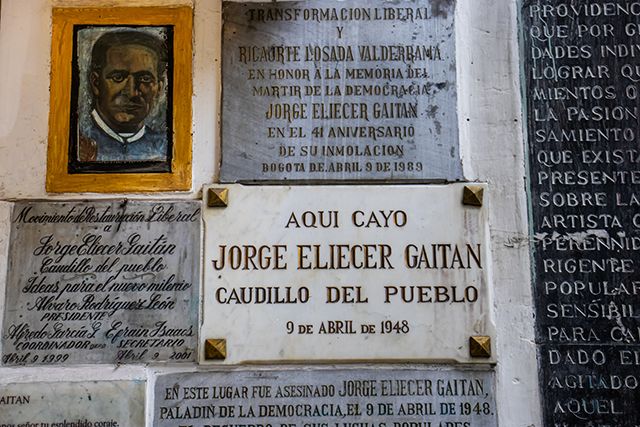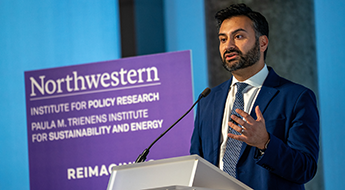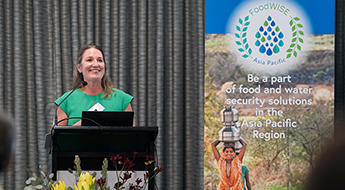Political Assassinations Lower Voter Turnout in Colombia
New study challenges assumptions about the aftermath of civil war violence
Get all our news
If we are aware of these effects, then we can bring more attention to the increased violence against local politicians, because this is happening everywhere.”
Ana Arjona
IPR Associate

Plaques in Bogotá mark the site of the assassination of Colombian politician Jorge Eliécer Gaitán in 1948.
On Sept. 1, 2019, mayoral candidate Karina García was killed on her way home from a campaign stop in Cauca, Colombia. Her candidacy had generated excitement—she might have become the area’s first female mayor—but threats soon followed. Five others traveling with her that day died, including her mother. García left behind a husband and a 3-year-old son.
Tragically, such violence is not rare in Colombia, where a decades-long civil war officially ended in 2016 but peace remains fragile. According to a new study in Proceedings of the National Academy of Sciences by political scientist and IPR associate Ana Arjona, nearly 2,000 local politicians were assassinated there between 1983 and 2023.
Arjona and her colleagues Mario Chacón and Laura García-Montoya find that these political assassinations depressed voter turnout in affected areas for as many as four election cycles—challenging past research that suggested civil war violence can actually mobilize political participation.
In a Q&A with IPR, Arjona discusses her findings and what they reveal about political violence and how to keep democracy alive in its wake.
The following conversation has been edited for length and clarity.
Why did you want to study the effects of political assassinations in Colombia?
A lot of research on civil war violence has found that violence increases political participation, especially after the war is over, but they only look at some types of violence.
During a civil war, you see very different types of violence happening. Political assassination—the frequency of it, the scale—was horrific. We started thinking about the effects of this type of violence.
We started with questions about the effects on political participation, but our larger project looks at the effects on the quality of local governance, too. If being a politician is dangerous, who ends up being a politician? You might get the most heroic and committed people. You could also get people who are willing to strike deals with armed actors to protect themselves. We know from the literature that the quality of politicians affects the quality of public goods provision and the way local governments are run.
We’re looking at effects on both supply and demand: the ‘supply’ of politicians or candidates and the ‘demand’ from voters.
Imagine if you see the candidate that you want to win an election, or any politician, being killed. What is your perception of democracy? Do you just give up? Do you get scared and not vote because you don't know if you are going against a powerful, violent person or group? Or the opposite: Do you participate more because you want to have your voice heard and push back?
What did you find in your study?
We do not find that political assassinations have a positive effect on [voter] participation, which is remarkable given what we know about past studies on civil war violence in general.
We find that the context in which these killings are happening matters, as does the target. If the person who is assassinated was a candidate and not an incumbent, the effect on voter turnout is larger in magnitude.
The surrounding levels of violence matter, in a way that may seem counterintuitive: If a place has more violence in general, the effect is smaller. This could mean that people are used to violence, but it can also be interpreted differently. Sometimes, if you're not observing a lot of surrounding violence, it means that you have a very powerful armed group that is in control. People may be scared of participating, and even more so when there is then a political assassination, which clearly signals that the armed actor has a position on who should win the election.
What do these findings mean for policy—what should we do next?
If we are aware of these effects, then we can bring more attention to the increased violence against local politicians, because this is happening everywhere. It’s not just Colombia, Mexico, Brazil. It’s Germany, it’s the U.S. Threats against all kinds of local officials are going up.
I don’t think we talk enough about how this is not just obviously wrong and unacceptable, but also how this can undermine democracy. If assassinations are putting these communities in Colombia on a different trajectory in terms of political participation, we should be doing things to recover trust in democracy.
More research on the mechanisms is essential. Is this fear? Is this just disillusionment with democracy—is that what’s driving voters’ decision to not show up to vote, even years after the event? If we better understand the mechanisms at work, we can see if people need more information [like] the stances of people running for office, for example.
It should inform how much we prioritize this topic, and the ways in which we not just prevent this kind of violence, but also decrease the short- and long-term effects on participation.
Thinking about a context like the U.S., how does political violence intersect with disinformation and misinformation?
First, I should say that you can’t take these findings in one context, Colombia, and extrapolate them to another. You have to take into account the nature of the violence—that is, if it’s political, social, criminal—and the type of targeting—for example selective, indiscriminate, collective.
In terms of the context, a lot of things matter: not just the surrounding levels of violence, but yes, misinformation could change people’s tolerance for political violence. Polls have shown that the percentage of Americans who would consider political violence acceptable has grown in the last few years, which is very scary. That could be connected to disinformation and misinformation. When people have false information about current events, they may take more extreme positions, including towards political violence. Such attitudes could also be related to polarization.
I also think that there is a banalization of violence in the way political parties, news shows, and opinion programs talk about it—which can also increase the tolerance for violence.
Acts of violence send very specific messages to people, and the ways in which those messages are received also varies. This is why understanding the context is so important.
Ana Arjona is a political scientist and IPR associate.
Photo credit: iStock
Published: May 19, 2025.


